Diploblastic Study guides, Class notes & Summaries
Looking for the best study guides, study notes and summaries about Diploblastic? On this page you'll find 33 study documents about Diploblastic.
Page 2 out of 33 results
Sort by

-
Biology 1108 Exam 3 Questions and Answers (Latest Update) 120 Questions | Graded A+
- Exam (elaborations) • 21 pages • 2023
-
- $15.49
- + learn more
Biology 1108 Exam 3 Questions and Answers (Latest Update) 120 Questions | Graded A+. Alpine - Correct Answers Similar to Tundra, Lacks permafrost, Budding - Correct Answers Form of asexual reproduction in which a bud/protrusion forms on an organism and eventually breaks off to form a new organism that is smaller than its parent. Fragmentation - Correct Answers A type of asexual reproduction in which one organism is broken into pieces, each of which develops into a new individual Partheno...
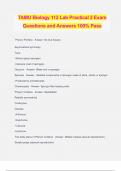
-
TAMU Biology 112 Lab Practical 2 Exam Questions and Answers 100% Pass
- Exam (elaborations) • 23 pages • 2024
- Available in package deal
-
- $12.49
- + learn more
TAMU Biology 112 Lab Practical 2 Exam Questions and Answers 100% Pass Phylum Porifera - Answer- No true tissues Asymmetrical symmetry Taxa: -Silicea (glass sponges) -Calcarea (rest of sponges) Osculum - Answer- Water exit in sponges Spicules - Answer- -Skeletal components of sponges made of silica, calcite or spongin -Produced by amoebocytes Choanocytes - Answer- Spong's filter-feeding cells Phylum Cnidaria - Answer- Diploblastic Radially symmetrical Cnidocytes Classes: -Anthozoa...

-
TAMU BIOLOGY 112 EXAM #3 Questions and Answers 100% Pass
- Exam (elaborations) • 33 pages • 2024
- Available in package deal
-
- $13.49
- + learn more
TAMU BIOLOGY 112 EXAM #3 Questions and Answers 100% Pass Select the TRUE statement about animal development: A.) Deuterostome development is indeterminate. B.) Mesoderm in protostomes arises as outpocketings of the primitive gut. C.) Radial cleavage is characteristic of protostome development. D) In deuterostomes, the blastopore ultimately becomes the mouth of the adult. E) All of the above are true. - Answer- Deuterostome development is indeterminate. During embryogenesis of diploblasti...
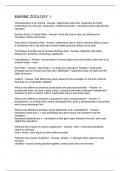
-
Marine Zoology #1
- Exam (elaborations) • 3 pages • 2024
-
- $9.99
- + learn more
Characteristics of an Animal - Answer- heterotroph (eat other organisms for food), multicellular (no cell wall, eukaryotic), motility/movement, *neurons/muscle cells (except sponges) Surface Area to Volume Ratio - Answer- limits the size of cells, as surface area increases volume decreases Importance of Surface Area - Answer- determines rate at which nutrients diffuse across a membrane into a cell and rate at which waste products diffuse out of cells Techniques Animals use to Increase S...
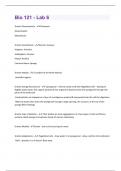
-
Bio 121 - Lab 6 exam (100% correct and graded A+)
- Exam (elaborations) • 6 pages • 2023
- Available in package deal
-
- $3.49
- + learn more
Grantia Characteristics - Eukaryotic Heterotrophic Multicellular Grantia Classification - Domain: Eukarya Kingdom: Animalia Subkingdom: Parazoa Phylum Porifera Common Name: Sponge Grantia Habitat - -Coastline of the North Atlantic -Intertidal regions Grantia Energy/Food Source - -Spongocoel - internal cavity lined with flagellated cells - beating of flagella draws water, fine organic particles & tiny organisms (bacteria) into the spongocoel through tiny pores of the body wall -Food ...

-
BIOL 181 EXAM 3 QUIZ 2024 A + graded 100% verified
- Exam (elaborations) • 4 pages • 2024
- Available in package deal
-
- $10.49
- + learn more
BIOL 181 EXAM 3 QUIZ 2024 A + graded 100% verified Diploblastic - answerhaving two germ layers; ectoderm and endoderm Triploblastic - answerhas three germ layers: the ectoderm, endoderm, and mesoderm. spiral vs radial cleavage - answerIn spiral cleavage, the division planes are not at 90 degree angles, resulting in blastomeres that are not aligned directly over or beside one another. Radial Cleavage: occurs such that the resulting daughter cells are located exactly on top of one another. ...

-
BIOLOGY 1108 Final Exam Questions and Answers Latest Updated 2024 (Graded A+)
- Exam (elaborations) • 21 pages • 2024
-
- $17.99
- + learn more
BIOLOGY 1108 Final Exam Questions and Answers Latest Updated 2024 (Graded A+) Alpine - Correct Answers Similar to Tundra, Lacks permafrost, Budding - Correct Answers Form of asexual reproduction in which a bud/protrusion forms on an organism and eventually breaks off to form a new organism that is smaller than its parent. Fragmentation - Correct Answers A type of asexual reproduction in which one organism is broken into pieces, each of which develops into a new individual Parthenogenesis...
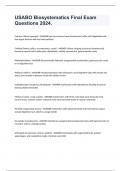
-
USABO Biosystematics Final Exam Questions 2024.
- Exam (elaborations) • 3 pages • 2024
-
Available in package deal
-
- $12.49
- + learn more
USABO Biosystematics Final Exam Questions 2024. Calcarea, Silicea (sponges) - ANSWER Lack true tissues; have choanocytes (collar cells-flagellated cells that ingest bacteria and tiny food particles) Cnidaria (hydras, jellies, sea anemones, corals) - ANSWER Unique stinging structures (nematocysts) housed in special cells (cnidocytes); diploblastic, radially symmetrical, gastrovascular cavity Plathyhelminthes - ANSWER Dorsoventrally flattened, unsegmented acoelomates; gastrovascular cavity ...
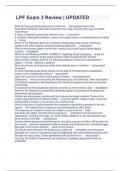
-
LPF Exam 3 Review | UPDATED
- Exam (elaborations) • 2 pages • 2023
-
- $8.99
- + learn more
LPF Exam 3 Review | UPDATED What do fungi and arthropods have in common - both groups have chitin Specialized symbiotic associations between the roots of plants and fungi are called - mycorrhizae A mass of hyphae is commonly referred to as - a mycelium A symbiotic association between fungus and a green alga or a cyanobacterium is called a - lichen Which of the following refers to a symbiotic relationships that involve fungi living between the cells in plants (several synthesize al...
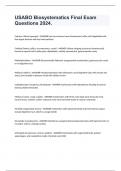
-
USABO Biosystematics Final Exam Questions With Correct Answers 2024.
- Exam (elaborations) • 3 pages • 2024
-
Available in package deal
-
- $10.49
- + learn more
USABO Biosystematics Final Exam Questions With Correct Answers 2024. Calcarea, Silicea (sponges) - ANSWER Lack true tissues; have choanocytes (collar cells-flagellated cells that ingest bacteria and tiny food particles) Cnidaria (hydras, jellies, sea anemones, corals) - ANSWER Unique stinging structures (nematocysts) housed in special cells (cnidocytes); diploblastic, radially symmetrical, gastrovascular cavity Plathyhelminthes - ANSWER Dorsoventrally flattened, unsegmented acoelomates; ...

That summary you just bought made someone very happy. Also get paid weekly? Sell your study resources on Stuvia! Discover all about earning on Stuvia


